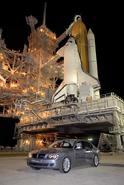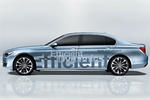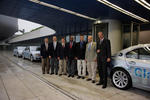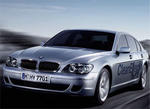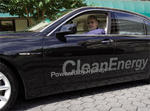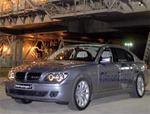
NASA prepared the Space Shuttle Endeavour to launch and finished testing the BMW Hydrogen 7 . The first hydrogen-powered luxury sedan, the BMW Hydrogen 7, has completed successfully an eight-week test period conducted by NASA.
BMW Press Release:
BMW AND NASA CONCLUDE TEST PERIOD OF BMW HYDROGEN 7
BMW Hydrogen 7-- which just completed an eight-week test by NASA -- is shown with the space shuttle Endeavour on the launch pad, prior to the launch of shuttle mission STS-118, at the Kennedy Space Center in Cape Canaveral on Tuesday, August 7, 2007.
The BMW Hydrogen 7, the first-ever hydrogen-powered luxury sedan, runs on a form of liquid hydrogen similar to what is used in the shuttles.
Eight-Week-Long Test Underscores Companies' Mutual Support of Hydrogen Technologies
Cape Canaveral, FL - August 8, 2007... As NASA engineers prepare to launch the Space Shuttle Endeavour today, BMW of North America and NASA announced the successful completion of an eight-week test period of the BMW Hydrogen 7 - the first-ever hydrogen-powered luxury sedan.
The test period, which was initiated under a Space Act Agreement between NASA and BMW, underscores the organizations' shared commitment to advancing hydrogen technologies and to exploring innovative transportation concepts and alternative energy sources.
"We are very proud to have been able to offer this test period of the BMW Hydrogen 7 to NASA, an organization that truly is on the forefront of discovery and innovation and with whom we share a unique common goal: the use and ongoing research of liquid hydrogen solutions," said Karl-Heinz Ziwica, Vice President of Engineering, BMW of North America.
"It is the high energy density of liquid hydrogen that allows the space shuttle to be accelerated into space. The same concept is used to power the BMW Hydrogen 7. Using hydrogen as a fuel can potentially reduce CO2 emissions by 90 percent. The BMW Hydrogen 7 is tangible proof that hydrogen-drive vehicles are a very viable option for the future of sustainable mobility, and we're pleased that NASA was able to experience it first-hand."
During the test period, NASA personnel had full access to the fleet of BMW Hydrogen 7s, which run
on a form of liquid hydrogen similar to what NASA uses in its shuttles. During their time with NASA, the vehicles - which feature a dual combustion engine capable of running on liquid hydrogen or gasoline and shifting seamlessly between the two - were conveniently refueled using the space center's liquid hydrogen fueling supply located on the space center's premises.
The BMW Hydrogen 7
Last year, BMW underscored its commitment to hydrogen-drive technologies with the debut of the BMW Hydrogen 7 - the world's first hydrogen-drive luxury performance automobile - to help stimulate demand for a viable hydrogen infrastructure in the long term. The car comes equipped with an internal combustion engine capable of running on
either liquid hydrogen or gasoline and is based on the BMW 760Li. The V12 cylinder engine delivers 260 hp; the top speed of the Hydrogen 7 is 143 mph and acceleration 0-60 mph is 9.2 sec. When driving in hydrogen mode, emissions of the BMW Hydrogen 7 are virtually nothing but water vapor. Since the start of research and development in alternative fuel sources more than 25 years ago, BMW has focused on liquid hydrogen as the appropriate source of energy for the automobile. The car features a high-tech vacuum super-insulated hydrogen tank in which liquid hydrogen can be stored at the extremely low temperature of -423 ° Fahrenheit (-253 °Celsius) for a long period of time - the same insulating effect as a 17-meter-thick layer of Styrofoam. One hundred BMW Hydrogen 7s have been built, and 25 are used in test programs in the US. The cars have already covered more than 1.3 million miles in test programs around the globe.
